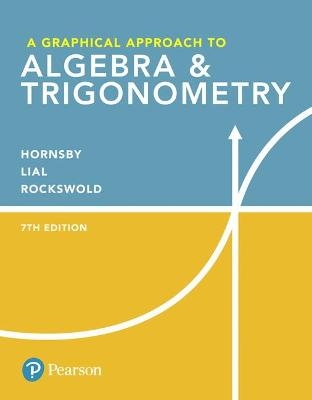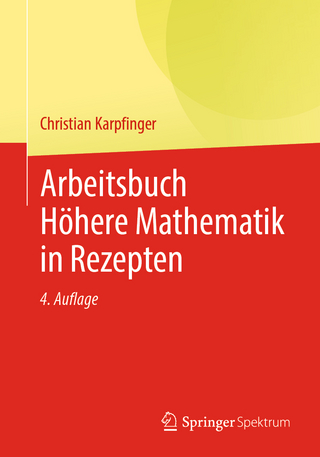
Graphical Approach to Algebra & Trigonometry, A
Pearson (Verlag)
978-0-13-469651-5 (ISBN)
Unifies the theme of a function — See, Solve, Apply
The Graphical Approach series by Hornsby, Lial, and Rockswold covers functions through a consistent, four-part analytical process. The authors ask students to:
1: [See] Examine the nature of the graph
2: Solve a typical equation analytically and graphically
3: Solve the related inequality analytically and graphically
4: Apply analytic and graphical methods to solve an application
This proven approach helps students gain a deep visual and graphical understanding of math, solidifying a stronger connection to the mathematical world around them.
Also available with MyLab Math
MyLab™ Math is the teaching and learning platform that empowers instructors to reach every student. By combining trusted author content with digital tools and a flexible platform, MyLab personalizes the learning experience and improves results for each student.
Note: You are purchasing a standalone product; MyLab Math does not come packaged with this content. Students, if interested in purchasing this title with MyLab Math, ask your instructor to confirm the correct package ISBN and Course ID. Instructors, contact your Pearson representative for more information.
If you would like to purchase both the physical text and MyLab Math, search for:
013486218X / 9780134862187 A Graphical Approach to Algebra & Trigonometry Plus MyLab Math with Pearson eText -- Access Card Package, 7/e
Package consists of:
0134696514 / 9780134696515 A Graphical Approach to Algebra & Trigonometry
0134859111 / 9780134859118 MyLab Math with Pearson eText - Standalone Access Card - for A Graphical Approach to Algebra & Trigonometry
About our authors When John Hornsby enrolled as an undergraduate at Louisiana State University, he was uncertain whether he wanted to study mathematics, education or journalism. His ultimate decision was to become a teacher, but after 25 years of teaching at the high school and university levels and 15 years of writing mathematics textbooks, all 3 of his goals have been realized; his love for teaching and for mathematics is evident in his passion for working with students and fellow teachers as well. His specific professional interests are recreational mathematics, mathematics history and incorporating graphing calculators into the curriculum. John’s personal life is busy as he devotes time to his family (wife Gwen, and sons Chris, Jack, and Josh). He has been a rabid baseball fan all of his life. John's other hobbies include numismatics (the study of coins) and record collecting. He loves the music of the 1960s and has an extensive collection of the recorded works of Frankie Valli and the Four Seasons. The late Marge Lial was always interested in math; it was her favorite subject in the first grade! Marge's intense desire to educate both her students and herself inspired the writing of numerous best-selling textbooks. Marge, who received Bachelor's and Master's degrees from California State University at Sacramento, was most recently affiliated with American River College. An avid reader and traveler, her travel experiences often found their way into her books as applications, exercise sets, and feature sets. She was particularly interested in archeology, and trips to various digs and ruin sites produced fascinating problems for her textbooks, involving such topics as the building of Mayan pyramids and the acoustics of ancient ball courts in the Yucatan. Gary Rockswold has been teaching mathematics for 33 years at all levels from seventh grade to graduate school, including junior high and high school students, talented youth, vocational, undergraduate and graduate students, and adult education classes. Now retired, he most recently served as professor of mathematics at Minnesota State University - Mankato. He graduated with majors in mathematics and physics from St. Olaf College in Northfield, Minnesota, where he was elected to Phi Beta Kappa. He received his Ph.D. in applied mathematics from Iowa State University. He has an interdisciplinary background and has also taught physical science, astronomy and computer science. Outside of mathematics, he enjoys spending time with his lovely wife and 2 children.
1. Linear Functions, Equations, and Inequalities
1.1 Real Numbers and the Rectangular Coordinate System
1.2 Introduction to Relations and Functions
Reviewing Basic Concepts (Sections 1.1 - 1.2)
1.3 Linear Functions
1.4 Equations of Lines and Linear Models
Reviewing Basic Concepts (Sections 1.3 - 1.4)
1.5 Linear Equations and Inequalities
Unifying Linear Functions
1.6 Applications of Linear Functions
Reviewing Basic Concepts (Sections 1.5 - 1.6)
Summary
Review Exercises
Test
2. Analysis of Graphs of Functions
2.1 Graphs of Basic Functions and Relations; Symmetry
2.2 Vertical and Horizontal Shifts of Graphs
2.3 Stretching, Shrinking, and Reflecting Graphs
Reviewing Basic Concepts (Sections 2.1 - 2.3)
2.4 Absolute Value Functions
Unifying Absolute Value Functions
2.5 Piecewise-Defined Functions
2.6 Operations and Composition
Reviewing Basic Concepts (Sections 2.4 - 2.6)
Summary
Review Exercises
Test
3. Quadratic Functions
3.1 Complex Numbers
3.2 Quadratic Functions and Graphs
Reviewing Basic Concepts (Sections 3.1 - 3.2)
3.3 Quadratic Equations and Inequalities
Unifying Quadratic Functions
3.4 Applications of Quadratic Functions and Models
Reviewing Basic Concepts (Sections 3.3 - 3.4)
Summary
Review Exercises
Test
4. Polynomial Functions of Higher Degree
4.1 Graphs of Polynomial Functions
4.2 Topics in the Theory of Polynomial Functions (I)
Reviewing Basic Concepts (Sections 4.1 - 4.2)
4.3 Topics in the Theory of Polynomial Functions (II)
4.4 Polynomial Equations, Inequalities, Applications, and Models
Reviewing Basic Concepts (Sections 4.3 - 4.4)
Unifying Polynomial Functions
Summary
Review Exercises
Test
5. Rational, Power, and Root Functions
5.1 Rational Functions and Graphs (I)
5.2 Rational Functions and Graphs (II)
5.3 Rational Equations, Inequalities, Models, and Applications
Reviewing Basic Concepts (Sections 5.1 - 5.3)
5.4 Functions Defined by Powers and Roots
5.5 Equations, Inequalities, and Applications Involving Root Functions
Reviewing Basic Concepts (Sections 5.4 - 5.5)
Unifying Root Functions
Summary
Review Exercises
Test
6. Inverse, Exponential, and Logarithmic Functions
6.1 Inverse Functions
6.2 Exponential Functions
Unifying Exponential Functions
6.3 Logarithms and Their Properties
Reviewing Basic Concepts (Sections 6.1 - 6.3)
6.4 Logarithmic Functions
6.5 Exponential and Logarithmic Equations and Inequalities
Unifying Logarithmic Functions
6.6 Further Applications and Modeling with Exponential and Logarithmic Functions
Reviewing Basic Concepts (Sections 6.4 - 6.6)
Summary Exercises on Functions: Domains, Defining Equations, and Composition
Summary
Review Exercises
Test
7. Systems and Matrices
7.1 Systems of Equations
7.2 Solution of Linear Systems in Three Variables
7.3 Solution of Linear Systems by Row Transformations
Reviewing Basic Concepts (Sections 7.1 - 7.3)
7.4 Matrix Properties and Operations
7.5 Determinants and Cramer's Rule
7.6 Solution of Linear Systems by Matrix Inverses
Reviewing Basic Concepts (Sections 7.4 - 7.6)
7.7 Systems of Inequalities and Linear Programming
7.8 Partial Fractions
Reviewing Basic Concepts (Sections 7.7 - 7.8)
Summary
Review Exercises
Test
8. Conic Sections, Nonlinear Systems, and Parametric Equations
8.1 Circles Revisited and Parabolas
8.2 Ellipses and Hyperbolas
Reviewing Basic Concepts (Sections 8.1 - 8.2)
8.3 The Conic Sections and Nonlinear Systems
8.4 Introduction to Parametric Equations
Reviewing Basic Concepts (Sections 8.3 - 8.4)
Summary
Review Exercises
Test
9. Trigonometric Functions and Applications
9.1 Angles, Arcs, and Their Measures
9.2 Trigonometric Functions and Fundamental Identities
9.3 Right Triangles and Evaluating Trigonometric Functions
9.4 Applications of Right Triangles
9.5 The Circular Functions
9.6 Graphs of the Sine and Cosine Functions
9.7 Graphs of the Other Circular Functions
9.8 Harmonic Motion
Summary
Review Exercises
Test
10. Trigonometric Identities and Equations
10.1 Trigonometric Identities
10.2 Sum and Difference Identities
10.3 Further Identities
10.4 The Inverse Circular Functions
10.5 Trigonometric Equations and Inequalities (I)
10.6 Trigonometric Equations and Inequalities (II)
Unifying Trigonometric Functions
Summary
Review Exercises
Test
11. Applications of Trigonometry and Vectors
11.1 The Law of Sines
11.2 The Law of Cosines and Area Formulas
11.3 Vectors and Their Applications
11.4 Trigonometric (Polar) Form of Complex Numbers
11.5 Powers and Roots of Complex Numbers
11.6 Polar Equations and Graphs
11.7 More Parametric Equations
Summary
Review Exercises
Test
12. Further Topics in Algebra
12.1 Sequences and Series
12.2 Arithmetic Sequences and Series
12.3 Geometric Sequences and Series
Reviewing Basic Concepts (Sections 12.1 - 12.3)
12.4 Counting Theory
12.5 The Binomial Theorem
Reviewing Basic Concepts (Sections 12.4 -12.5)
12.6 Mathematical Induction
12.7 Probability
Reviewing Basic Concepts (Sections 12.6 - 12.7)
Summary
Review Exercises
Test
R. Review: Basic Algebraic Concepts
R.1 Review of Sets
R.2 Review of Exponents and Polynomials
R.3 Review of Factoring
R.4 Review of Rational Expressions
R.5 Review of Negative and Rational Exponents
R.6 Review of Radicals
Test
Appendices
A: Geometry Formulas
B: Vectors in Space
C: Polar Form of Conic Sections
D: Rotation of Axes
Instructor's Answers Answers to Selected Exercises (Note: In the AIE, Instructor's Answers replaces Answers to Selected Exercises.) Index
| Erscheinungsdatum | 02.02.2018 |
|---|---|
| Sprache | englisch |
| Maße | 221 x 284 mm |
| Gewicht | 2200 g |
| Themenwelt | Mathematik / Informatik ► Mathematik ► Algebra |
| ISBN-10 | 0-13-469651-4 / 0134696514 |
| ISBN-13 | 978-0-13-469651-5 / 9780134696515 |
| Zustand | Neuware |
| Informationen gemäß Produktsicherheitsverordnung (GPSR) | |
| Haben Sie eine Frage zum Produkt? |
aus dem Bereich


